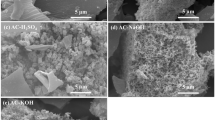Abstract
Carbon materials enriched with nitrogen and oxygen surface functional groups were obtained by pyrolyzing strained beer yeast at 750 °C under an inert atmosphere. Physical and surface properties of the carbon obtained were characterized by X-ray powder diffraction, transmission electron microscopy, high-resolution transmission electron microscopy, Raman spectrometry, and X-ray photoelectron spectroscopy. Results show that the carbon possesses an amorphous structure, a spherical morphology, and a high density of surface functional groups. Electrochemical properties were evaluated by cyclic voltammetry, a galvanostatic charge–discharge technique, and electrochemical impedance spectroscopy. The carbon has 989.65 mAh·g−1 of initial discharge capacity and a stable cycle performance for a Li–C cell. A specific capacitance of 120 F·g−1 was obtained for a single carbon electrode and good cycle performance was achieved for a symmetrical supercapacitor fabricated using this carbon. These carbons derived from strained beer yeast have promising applications in energy storage and conversion systems.







Similar content being viewed by others
References
Szymański GS, Zbigniew K, Biniak S, Świątkowski A (2002) Carbon 40:2627 doi:10.1016/S0008-6223(02)00188-4
Kim YJ, Lee HJ, Lee SW, Cho BW, Park CR (2005) Carbon 43:163 doi:10.1016/j.carbon.2004.09.001
Pittman CU Jr, He GR, Wu B, Gardner SD (1998) Carbon 36:25 doi:10.1016/S0008-6223(97)00147-4
Xie F, Phillips J, Silva IF, Palma MC, Menéndez JA (2000) Carbon 38:691 doi:10.1016/S0008-6223(99)00156-6
Hu CC, Wang CC (2004) J Power Sources 125:299 doi:10.1016/j.jpowsour.2003.08.002
Bagreev A, Angel Menendez J, Duhkno I, Tarasenko Y, Bandosz TJ (2004) Carbon 42:469 doi:10.1016/j.carbon.2003.10.042
Bonino F, Brutti S, Reale P, Scrosati B, Gherghel L, Wu J et al (2005) Adv Mater 17:743 doi:10.1002/adma.200401006
Inagaki M (2000) New carbons. Elsevier Science, Oxford
Su FB, Zhao XS, Wang Y, Zeng JH, Zhou ZC, Jim YL (2005) J Phys Chem B 109:20200 doi:10.1021/jp0541967
Wu YP, Fang SB, Jiang YY (1999) Solid State Ionics 120:117 doi:10.1016/S0167-2738(98)00158-1
Nakamura K, Fujitsuka M, Kitajima M (1990) Phys Rev B 41:12260 doi:10.1103/PhysRevB.41.12260
Deon H, Andrey B, Bandosz TJ (2004) Langmuir 20:3388 doi:10.1021/la0360613
Liu JW, Shao MW, Tang Q, Zhang SY, Qian YT (2003) J Phys Chem B 107:6329 doi:10.1021/jp034881i
Yang Q, Xu W, Tomita A, Kyotani T (2005) Chem Mater 17:2940 doi:10.1021/cm047830m
Lespade P, Al-jishi R, Dresselhaus MS (1982) Carbon 20:427 doi:10.1016/0008-6223(82)90043-4
Biniak S, Szymański G, Siedlewski J, Swiatkowski A (1997) Carbon 35:1799
Stańczyk K, Dziembaj R, Piwowarska Z, Witkowski S (1995) Carbon 33:1383 doi:10.1016/0008-6223(95)00084-Q
Darmstadt H, Roy C, Kaliaguine S (1994) Carbon 32:1399 doi:10.1016/0008-6223(94)90132-5
Figueiredo JL, Pereira MFR, Freitas MMA, Órfão JJM (1999) Carbon 37:1379 doi:10.1016/S0008-6223(98)00333-9
Flandrois S, Simon B (1999) Carbon 37:165 doi:10.1016/S0008-6223(98)00290-5
Frackowiak E, Gautier S, Gaucher H, Bonnamy S, Beguin F (1999) Carbon 37:61 doi:10.1016/S0008-6223(98)00187-0
Rahner D, Machill S, Schlorb H, Siury K, Kloss M, Plieth W (1998) J Solid State Electrochem 2:78 doi:10.1007/s100080050068
Lery S, Blanchard F, Dedryvere R, Martinez H, Carre B, Lemordant D et al (2005) Surf Interface Anal 37(10):773 doi:10.1002/sia.2072
Liu HT, He P, Li ZY, Liu Y, Li JH (2005) Electrochim Acta 51(10):1925 doi:10.1016/j.electacta.2005.06.034
Koh M, Nakajima T (2000) Carbon 38(14):1947 doi:10.1016/S0008-6223(00)00040-3
Conway BE (1999) Electrochemical supercapacitor: scientific fundamentals and technological applications. Kluwer-Plenum, New York
Qu DY (2002) J Power Sources 109(2):403 doi:10.1016/S0378-7753(02)00108-8
Lufrano F, Staiti P, Minutoli M (2004) J Electrochem Soc 151(1):64 doi:10.1149/1.1626670
Acknowledgement
This work was supported by Yangtze Normal University Research Start-up Foundation and Science and Technology Research Project of Chongqing Education Board (KJ081304).
Author information
Authors and Affiliations
Corresponding author
Rights and permissions
About this article
Cite this article
Zhang, GQ., Zhang, ST. Characterization and electrochemical applications of a carbon with high density of surface functional groups produced from beer yeast. J Solid State Electrochem 13, 887–893 (2009). https://doi.org/10.1007/s10008-008-0623-2
Received:
Revised:
Accepted:
Published:
Issue Date:
DOI: https://doi.org/10.1007/s10008-008-0623-2




